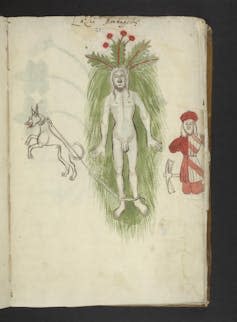In 1897, one person, Mr. Burgess, Clerk of Works at Oxford University, donated two shriveled potatoes to the Pitt Rivers Museum. He usually kept them in his pockets. They were the ultimate “jacket” potatoes.
The Pitt Rivers Museum in Oxford is committed to categorizing and exhibiting the “democracy of objects” not by time or nation, but by human use. Since the potato is fairly ubiquitous in human culture, it means that there are many in the museum’s collection.
In addition to the Burgess donation, 11 other corrugated specimens are cataloged in the museum’s collections, and are neatly labelled. The names of the previous owners are usually not known because most of the potatoes were stolen before they were donated.
But why would anyone want to steal a wrinkled potato? The answer is that these were just any purloined spuds. They were healing magic believed to be cures for rheumatism – and if stolen, they were thought to be even more effective.
In the Victorian era, and for centuries before, various types of vegetables were carried whole, or ground up and put into bags to be hung around the neck in the hope of warding off or curing illness.
Plants as drugs
Before modern pharmacy, most medical matter (substances used in medical practice, or drugs) herbal. Their use was described in books by the ancient Greek physician Pedanius Dioscorides (40-70 AD) and in Pliny’s Natural History (1st century AD), an encyclopedia written in ancient Rome. These books from antiquity continued to be reference guides throughout the Renaissance.

In his book Pliny described the uses of plants such as the mandrake root, which was considered to resemble a complete human figure with what were called “the virile members”. Amulets of the root were made to be worn to promote fertility and love magic. Using it in this way, there is also a reference in the Song of Solomon in the Bible.
Because the root contained hallucinogenic and narcotic active ingredients, it was also used as an anesthetic and to relieve arthritis pain. By the 16th century, botanist John Gerard’s Herball or General Historie of Plants related the legend that if one pulled it from the ground, the root would scream, killing anyone who heard it (perhaps as a result of a few bad trips).
Illnesses caused by the planets
Paracelsus, a Swiss doctor from the 16th century, explained these theories, claiming that each plant had something called a “signature” or sign of its medicinal function that resembled the part of the body or the disease it could cure.
For example, lentils and rapeseed were thought to be sympathetic to the treatment of smallpox because the seeds resembled the pustules of a thorn. The appropriate herbs, pulses, seeds or vegetables were bundled and worn around the neck to induce healing.
Other plants, such as sunflowers, were thought to promote the hot and dry qualities of the sun, good for warming you up if you suffered from a cold.
Plant therapy was also linked to the use of astrology in early medicine. The planets were thought to rule the fluids or “humors” in the body (black bile, blood, yellow bile, and phlegm), all of which had to be kept in careful balance to promote health. Imbalances were believed to be cured by bleeding or by ingesting herbal medicine, or in some cases, by wearing an appropriate plant amulet.
Diseases caused by a particular planet may be cured by the herb of the other planet. For example, lunar diseases were thought to be caused by an abundance of cold and damp humours, as the Moon ruled the waters in the tides.
Thus diseases that produced phlegm and caused sneezing such as the common cold, or those that produced fluid-filled tumors, such as scrofula, were considered to be ruled by the Moon. These lunar diseases could be cured by solar herbs or tinctures, which were hot and drying like sunflower. So the sunflower cure. Lettuce that was watery was to be avoided.
But what about our potato and its connection to rheumatism?
A poison, called solanine, is present in green potatoes and potato eyes (the sprouts like roots). Solanine is closely related chemically to another poisonous tropane alkaloid, called atropine in deadly nightshade. In fact, the potato is called a night vegetable.
Atropine cream was applied in the Victorian era, sometimes in combination with morphine, to “relieve rheumatism, sciatica and neuralgia”. Although there is no scientific basis for this, atropine is used in modern medicine to dilate the pupils or increase heart rates in a medical emergency.
There have been several cases of murder involving higher levels of atropine in tea or gin and tonic, the bitter taste of which was masked by the drink.
As for why the potatoes needed to be stolen to cure rheumatism, we don’t know for sure but it certainly adds to their magic.


Looking for something good? Cut through the noise with a curated selection of the latest releases, live events and shows, straight to your inbox every fortnight, on Fridays. Register here.
This article from The Conversation is republished under a Creative Commons license. Read the original article.


Anna Marie Roos receives funding from the National Science Foundation, the Andrew Mellon Foundation, the Arts and Humanities Research Council, the British Academy, the Royal Society of London, the Wellcome Trust, the McKnight Foundation, the Society of Authors, the Record Society Lincoln , and the Marc Fitch Fund